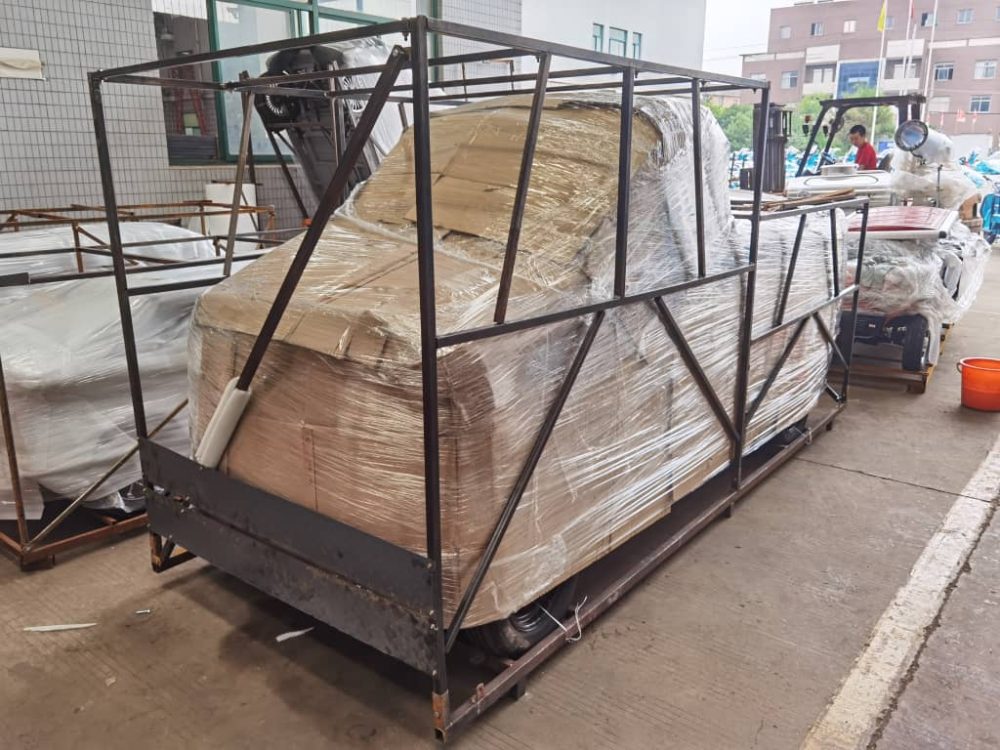Some readers may recall that a few months ago I bought a cheap electric mini-truck on Alibaba. I know this because I’ve gotten emails almost daily ever since, asking if my Chinese electric pickup truck has arrived (with some humorously calling it my F-50). Well, now I can finally answer, “Yes!” and share with you exactly what I received.
But first, a tiny bit of background.
How did I buy a mini truck?
I originally found the truck while perusing Alibaba in search of a weekly nugget of gold for my Awesomely Weird Alibaba Electric Vehicle of the Week column.
I found a $2,000 electric truck that looked perfect, except that it was about 2:3 scale. And it only went 25 mph. And only had a 3 kW motor. And you had to pay extra for batteries, shipping, etc.
But glossing over all those hiccups, the truck looked as silly as it did awesome. It was a bit small, but had a lot of charm. So I started talking with the trading company (a little outfit known as ChangLi that also supplies a few importers in the US).
I was able to spec the truck with a hydraulic dumping bed, air conditioning, and a giant (for this small truck) 6 kWh lithium-ion battery.
Those upgrades cost me around $1,500 on top of the base price, plus I had to pay an outrageous $2,200 sea shipping rate, but at least my truck was on its way to me now.

Shipping an electric truck from China
The shipping process seemed to take forever. At first all went well, and a couple weeks after paying, my truck was headed to the port. It sat around for another couple weeks until it made it into a container and onto a boat, then six weeks later, the boat arrived in Miami. The only problem was that my truck was no longer on it. No one knew where it went and I spent several days calling the forwarding company, the logistics company, my customs broker, and the Chinese trading company. No one could explain it.
Finally, the Chinese trading company heard back from the shipper on their end that my container had been offloaded in South Korea and put on a second container ship – something about the water in port not being deep enough.
Long story short, the truck finally arrived in Miami, but then got held up in customs for a few more weeks. Once it finally popped out the other end of customs, I paid an additional $500 to some dude I found on Craigslist and he hauled the crated-up truck on a bigger flatbed truck to my parents’ property in Florida that would become the truck’s new home.
The cage it was shipped in was beaten to hell and back, but the truck was miraculously fine. There I unboxed the truck (a process I caught on video along with my first test rides).
What showed up?
Believe it or not, the truck is actually even better than I had hoped.
It’s not particularly powerful, though the 3 kW motor and 5.4 kW peak controller give it plenty of low-speed oomph for hauling around on my parents’ property.
The dump bed is awesome and I’ve already put it to good use collecting yard waste around the land and hauling it back to the dump pile.
The truck itself is surprisingly well-made in some regards. It features full metal body panels, electric windows and doors with key fob for locking, and a full light package with blinkers, head lights, spot lights, tail lights, reverse lights, etc. There’s a backup camera, steel cargo rack and bed rack, high power charger, windshield wiper with washer fluid, and the air conditioning is even quite powerful (as tested in hot, humid Florida).
I can even connect my phone to the Bluetooth and play music or movies on the infotainment system.
The whole thing could use some better rustproofing as in a couple spots I can already notice a bit of rust after the months-long sea voyage.

This definitely isn’t a golf cart – it’s a fully enclosed vehicle, albeit a slow one. I was mostly driving off-road where I rarely got close to the top speed of 25 mph (40 km/h) due to the rough suspension, though I did a small amount of on-road driving to verify the speed, which was nearly exactly the promised 25 mph.
I didn’t do much road riding, though, mostly due to the next issue.
Are ChangLi cars and trucks street legal?
Unfortunately, these ChangLi cars and trucks are not street legal, nor are pretty much any Chinese-made neighborhood electric vehicles (NEVs) or low speed vehicles (LSVs).
The issue is that these are a federally approved class of motor vehicle (LSV) and there are actual Federal Motor Vehicle Safety Standards that apply, believe it or not.
I used to think that NEVs and LSVs could be street legal as long as they went 25 mph and had equipment like blinkers, seat belts, etc. Unfortunately, that’s not correct. It’s waaaay more complicated than that.
The cars would actually need to fulfill a long list of requirements including having DOT parts throughout in order to be street legal. The glass has to come from DOT-registered glass factories, the backup camera has to come from DOT-registered backup camera factories, etc. It’s not enough to simply go 25 mph and have seat belts and blinkers.
Even if the cars had all the necessary DOT parts, the factory that produces them in China also has to be registered with the NHTSA to allow the cars to be street legal in the US. So while there are already a few US companies importing these into the US, some of which erroneously claim that the cars are street legal because they go 25 mph, the sad fact is that no we can’t actually register these cars or take them on the road. It would take a massive undertaking to either produce these in the US or build a factory in China that was DOT-compliant and could be registered with the NHTSA. Perhaps that explains why a 25 mph 4-seater Polaris GEM costs a head-scratching $15,000 with lead acid batteries and no doors or windows!

How much did it cost, all in?
You often see these things listed at $2,000 or so on Alibaba and other Chinese shopping sites. The true cost is actually much higher. As I mentioned, right off the bat I had to add $1,000 for the big battery, $500 for the upgrades I chose, and $2,200 for sea shipping.
On the US side, I had to add in another $1,000 or so in duties and broker fees, plus some arrival charges. Ultimately I wound up north of $7,000 for the whole kit and caboodle. That’s definitely more than I was anticipating spending. Back when I made the order I had hoped to get away with $6,000 in damage.
While some people might call the final price a rip-off, consider the alternative. A crappy golf cart with flooded lead acid batteries starts at around $6,000 today. A halfway decent one is $8k. The really nice ones land in the $10-12k range. And even then, all you have is a golf cart. It’s not enclosed, meaning you get rained on. There’s no air conditioning. No wipers. No locking doors. No windows (electric or otherwise). No adjustable bucket seats. No infotainment system. No sun roof. No truck bed with hydraulic dump, etc.
So while some people might consider this a glorified golf cart (and I must concede that they have something of a point), it is both cheaper than a golf cart and also much more capable with utility that you don’t get with a golf cart.
What now?
Even though the truck isn’t street legal, that’s fine with me. I didn’t get it for that purpose, and it certainly doesn’t have the safety equipment that would make me comfortable using it in traffic anyway.
Instead, it’s a work truck. I’ll use it (or more likely my parents will use it more than me) as a farm truck on their property. It’s already proven great for that task in the first couple of days I’ve had it. We’ve used it around the land for collecting fallen limbs and debris, for lugging moving boxes and gear around the property, and just for having fun riding around to visit the neighbors!
It sure beats a gas-powered UTV since I never have to fill it up or choke on exhaust. And the same goes for just getting some old beater gas truck – I prefer my fun little EV that can do everything I need around this place.
At this point I’m excited to start modifying the truck. It’s already a great base, though it could use some work. The suspension isn’t great and I’m not sure how much I’ll be able to do there. Some softer springs could be a decent start.
But I’ll also be working on some other additions. The truck could use some good rustproofing, so that’s another area to start.
I’m also thinking of putting a small solar panel on the top of the cab. Even a relatively low-power one, such as a 50W panel, could be fairly effective. Assuming 100 wh/mi efficiency for the truck, even just a few miles of use around the property per day could be completely offset by passive solar charging.
I did a test with a Jackery 1500 solar electric generator and found that I could get a solid charge from the sun with 400W of solar panels, though it would require lugging around the unit and panels, or creating a semi-permanent installation somewhere around here.

I also want to add some mounts on the hydraulic lifting bed so my parents can pickup their trash cans and drive them down their country road-like driveway all the way to the public road for trash pickup.
I guess I should probably paint a racing stripe on it, too, so I can squeeze an extra few mphs out of it.
There are some other fun mods on my list as well. A bike ramp, a ham radio, maybe an AC inverter so I can charge devices like power tools directly from the truck’s 6 kWh battery. I’m open to suggestions too, if you have any ideas. Meet me in the comments section!
And I’ll be sure to update further down the road to let you know how my mini-truck is holding up over time. Until then, catch you on the (dirt) road!
Subscribe to Electrek on YouTube for exclusive videos and subscribe to the podcast.















